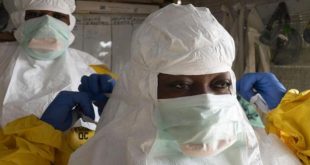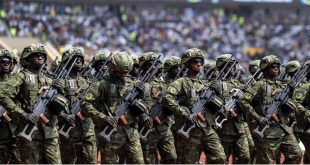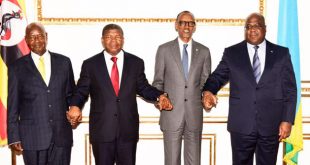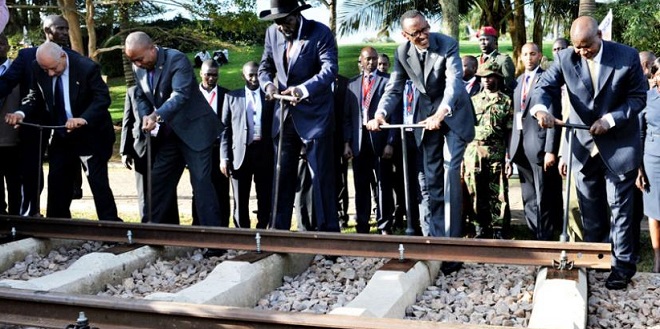
Nairobi, Kenya | THE INDEPENDENT | All transit cargo destined for Uganda, Rwanda and South Sudan will from June 1 be picked from Naivasha and not Mombasa, or be transported by Metre Gauge Railway to Tororo, then Kampala.
Fuel products will be transported by pipeline to Kisumu and thereafter through Lake Victoria to Port Bell or Jinja.
The decisions were Friday communicated by Kenya’s Minister in charge of transport James Macharia, who said it comes after a go ahead was given at the May 12th East African Community video conference of the Presidents of Kenya, Rwanda, and South Sudan.
The leaders asked their respective ministers to consider appropriate cross border transportation modalities to reduce human traffic movement without impacting negatively on transportation of cargo across the borders. Kenya has built its section of the Standard Gauge Railway (SGR) from Mombasa to Naivasha, where they have set up an Inland Container Depot (ICD).
“All transit cargo destined for Uganda, Rwanda and South Sudan will be transported either on Standard Gauge Railway (SGR) for clearance at the Inland Container Depot (ICD) at Naivasha or Metre Gauge Railway to Tororo-Kampala. All transit cargo railed to the Inland Container Depot (ICD) at Naivasha will be collected by trucks to the Partner States via Busia or Malaba,” Macharia said in a statement.
COVID-19 new factor
Rail transport is one of several measures being taken to reduce the spread of COVID-19 by truck drivers. Over half of the close to 300 positive tests for COVID-19 in Uganda are of truck drivers.
Uganda has now decided to only allow foreign truck drivers with a negative test result into the country.
In Kenya, only drivers with COVID-19 free certificates are able to enter the ICD Naivasha or Port of Mombasa to pick cargo.
The Naivasha ICD will reduce congestion in Nairobi and Mombasa and will reduce the number of trucks on the the roads.
It also has space for the Ugandan, Rwandan, South Sudanese and Tanzanian revenue authorities to operate from.
Border chaos
Meanwhile, more than 500 trucks are currently stuck at different points of entry within the East African Community because countries within the bloc do not trust COVID-19 test results from the others, reports URN.
Countries within the East African Community bloc began testing drivers who enter and leave the country from the borders. In Uganda, tests are being conducted at Elegu in Northern Uganda and Mutukula in Southern Uganda, at the Tanzanian Border.
While the move is aimed at solving the COVID-19 equation, it has become a burden to truck drivers, according to the Uganda Truck Drivers Association because countries doubt the results issued by other jurisdictions. They add that because of that, drivers from all over East Africa are stuck at points of entry with cargo.
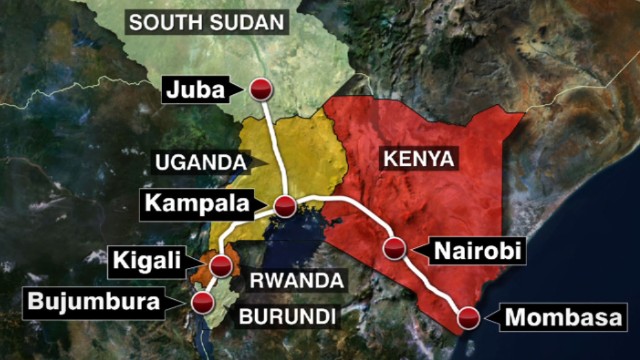
*****
FULL NOTICE
NOTICE ON TRANSIT CARGO
The Heads of State, Their Excellencies President Paul Kagame of the Republic of Rwanda; President Uhuru Kenyatta of the Republic of Kenya; President Yoweri Kaguta Museveni of the Republic of Uganda and President Salvar Maryardit Kiir of the Republic of South Sudan during their Consultative Meeting of the East African Community held by Video Conference on 12th May 2020 considered the current status of the outbreak of the Covid-19 Pandemic in the region and directed the Ministers responsible for Health, Transport, and EAC Affairs to adopt a Digital Surveillance and Tracking System for drivers and also as the Focal Persons to immediately work on a Regional mechanism for monitoring of truck drivers to reduce the impact of the Pandemic.
Following the directive by the Heads of State, the Partner States Ministers in charge of Transport, in recognition of the need to contain the spread of the Covid-19 pandemic within the Region, have considered appropriate cross border transportation modalities to reduce human traffic movement without impacting negatively on transportation of cargo across the borders and consequently direct as follows:
The Nairobi – Naivasha SGR Project is part of the proposed Mombasa – Nairobi – Malaba /Kampala Standard Gauge Railway Project and therefore, the Mombasa – Naivasha SGR, which has overall length of 600 kilometre up to the Inland Container Depot at Naivasha will reduce the road distance to three Partner States of Uganda, Rwanda and South Sudan by 600 kilometres, and will subsequently reduce interactions along the corridor and thus facilitate the containment of the Covid-19;
Since Kenya Ports Authority (KPA) as the lead agency on port matters has provided requisite office accommodation to the Kenya Revenue Authority, Uganda Revenue Authority, Rwanda Revenue Authority and the South Sudan Revenue Authority, deployment of the staff to the Inland Container Depot (ICD) at Naivasha is expected to be finalised to ensure smooth clearance of the cargo;
All transit cargo destined for Uganda, Rwanda and South Sudan will be transported either on standard gauge railway (SGR) for clearance at the Inland Container Depot (ICD) at Naivasha or Metre Gauge Railway to Tororo/Kampala. All transit cargo railed to the Inland Container Depot (ICD) at Naivasha will be collected by trucks to the Partner States via Busia or Malaba. Further, fuel products will be transported by pipeline to Kisumu and thereafter by lake Victoria to Port Bell or Jinja;
All the transit cargo/containers transported on SGR will be armed only at the Inland Container Depot (ICD) at Naivasha to be tracked through the Regional Electronic Cargo Tracking System; and
All exports (both full and empty exports) not railed on metre gauge railway will be delivered to the Inland Container Depot (ICD) at Naivasha for railage to the Port of Mombasa.
The directives will become effective after ten (10) days from the date of this notice and, for the avoidance of doubt, from 1st June 2020.
JAMES MACHARIA, EGH.
MINISTER IN CHARGE OF TRANSPORT
REPUBLIC OF KENYA
 The Independent Uganda: You get the Truth we Pay the Price
The Independent Uganda: You get the Truth we Pay the Price
